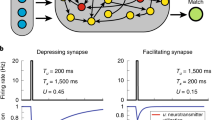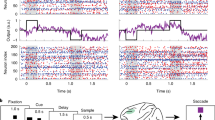Abstract.
We analyse a simplified form of the frontal lobe architecture of cortico-basal ganglia-thalamo-cortical loops to determine the manner in which they can learn temporal sequences as part of working memory activity. In particular, we consider how the temporal duration of activity can arise in this setting. We start from a hard-wired version in which temporally extended activity is created by the `long' loop of cortex → basal ganglia → thalamus → cortex, and show it arises from a near saddle-node bifurcation. The manner in which the transition between patterns occurs is also considered. This is then extended to analyse the temporal sequence storage and regeneration abilities of trained networks with a similar architecture. The temporal dynamics of this activity is also analysed. Implications of this for other working memory activities and for understanding the architecture of the frontal lobes are discussed in conclusion.
Similar content being viewed by others
Author information
Authors and Affiliations
Additional information
Received: 12 April 1999 / Accepted in revised form: 5 November 1999
Rights and permissions
About this article
Cite this article
Taylor, J., Taylor, N. Analysis of recurrent cortico-basal ganglia-thalamic loops for working memory. Biol Cybern 82, 415–432 (2000). https://doi.org/10.1007/s004220050595
Issue Date:
DOI: https://doi.org/10.1007/s004220050595




